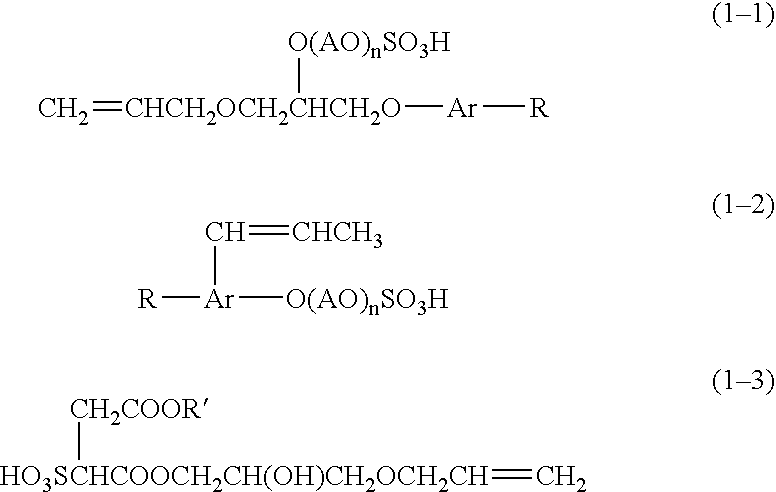Composite resin particle
a technology of composite resin and resin particles, applied in the field of composite resin particles, can solve the problems of paint peeling easily, poor adhesiveness to a substrate, and reduced affinity of resin particles obtained by solubilized resin suspension methods
- Summary
- Abstract
- Description
- Claims
- Application Information
AI Technical Summary
Benefits of technology
Problems solved by technology
Method used
Image
Examples
production example 1
A reaction vessel fitted with a stirrer and a thermometer was charged with 47 parts of styrenated phenol EO adduct (Eleminol HB-12, SANYO KASEI KOGYO) and 232 parts of bisphenol A diglycidyl ether (Epikote 828, YUKA SHELL), which were dissolved uniformly.
Then, water was added dropwise to the reaction vessel with stirring. Upon adding 31 parts of water, the inside of the reaction vessel was emulsified and became milky white. After a further dropwise addition of 224 parts of water, an emulsion (1) was obtained.
This emulsion (1) was heated to 70° C., and treated dropwise with a mixture of 20 parts of ethylene diamine and 446 parts of water over a period of 2 hours while keeping the temperature at 70° C.
After completion of the dropwise addition, the reaction and the maturing were ensured at 70° C. for 5 hours followed by 90° C. for 5 hours, whereby obtaining an amine-cured epoxy resin aqueous dispersion [resin microparticle (A1) dispersion].
The [resin microparticle (A1) dispers...
production example 2
A reaction vessel fitted with a stirrer and a thermometer was charged with 683 parts of water, 11 parts of methacrylic acid EO adduct sulfate sodium salt (Eleminol RS-30, SANYO KASEI KOGYO), 139 parts of styrene, 138 parts of methacrylic acid and 1 part of ammonium persulfate, which were stirred at 400 rpm for 15 minutes to obtain a white emulsion.
This emulsion was heated to 75° C. and reacted for 5 hours. Then 30 parts of a 1% aqueous solution of ammonium persulfate was added, and the mixture was matured at 75° C. for 5 hours to obtain an aqueous dispersion [resin microparticle (A2) dispersion] of a vinyl resin (styrene-methacrylic acid-methacrylic acid EO adduct sulfate sodium salt copolymer).
The [resin microparticle (A2) dispersion] was observed by an LA-920, which revealed the volume average particle diameter of (A2) was 0.12 μm.
A part of the [resin microparticle (A2) dispersion] was dried to isolate a resin portion {resin microparticle (A2)}. The Tg of (A2) was 155° C.
production example 3
A reaction vessel fitted with a condenser, stirrer and nitrogen inlet was charged with 343 parts of bisphenol A EO 2-mole adduct, 166 parts of isophthalic acid and 2 parts of dibutyltin oxide, and the reaction was conducted under atmospheric pressure at 230° C. for 8 hours, followed by the reaction for 5 hours under reduced pressure of 10 to 15 mmHg, and then the mixture was cooled to 110° C., combined with 17 parts of isophorone diisocyanate in toluene, reacted for 5 hours at 110° C., made free of solvent, whereby obtaining an [urethane-modified polyester (1)] whose Mw was 72,000 and whose isocyanate content was 0.7%.
On the other hand, 570 parts of bisphenol A EO 2-mole adduct and 217 parts of terephthalic acid were subjected to a polycondensation at 230° C. for 6 hours similarly as described above to obtain a non-modified [polyester (2)] whose Mn was 2,400, whose hydroxyl value was 51 and whose acid value was 5.
200 parts of the [urethane-modified polyester (1)] and 800 parts ...
PUM
| Property | Measurement | Unit |
|---|---|---|
| Temperature | aaaaa | aaaaa |
| Fraction | aaaaa | aaaaa |
| Percent by mass | aaaaa | aaaaa |
Abstract
Description
Claims
Application Information
 Login to View More
Login to View More - R&D
- Intellectual Property
- Life Sciences
- Materials
- Tech Scout
- Unparalleled Data Quality
- Higher Quality Content
- 60% Fewer Hallucinations
Browse by: Latest US Patents, China's latest patents, Technical Efficacy Thesaurus, Application Domain, Technology Topic, Popular Technical Reports.
© 2025 PatSnap. All rights reserved.Legal|Privacy policy|Modern Slavery Act Transparency Statement|Sitemap|About US| Contact US: help@patsnap.com

